|
The
Photographs of Dr. Cook:
From Albums in the Attic to
Digital CD
.
By
Laura J. Kissel/Polar
Curator
The Ohio State University
Byrd Polar Research Center
Archival Program
The
Background for the project
It
is a well-known fact among
Cook scholars that Dr. Cook
was an excellent
photographer. The Cook
Collection housed at The
Ohio State University
Archives (OSUA) is rich in
photographic resources.
However, the Polar
Collections as a whole are
not typically used by the
University community, but
rather by patrons not
located near the Archives.
This situation necessitates
a process in which we can
provide a viewing copy of
images for patrons so that
they can make selection
decisions. To improve this
process, over the past year
we have been busy scanning
selected categories of
images from the Frederick
A. Cook Society (FACS)
Collection.
|
Mt.
McKinley, 1903, 1906 |
|
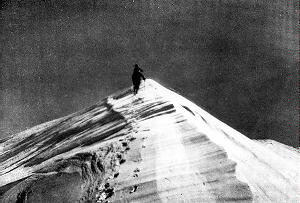
'Snow
above 20,000 ft. was
packed hard' |
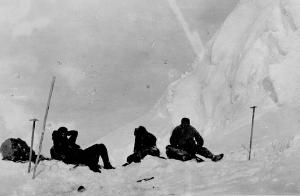
On
the west ridge in
1903 |
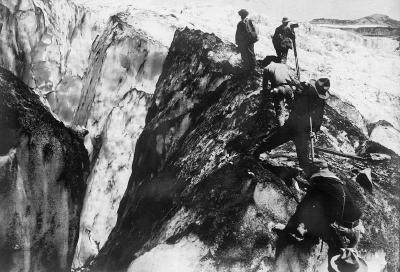 .... ....
Barrill
with flag in 1906, ..
Cook's summit photo.. |
|
Cutting
ice steps during the
climb
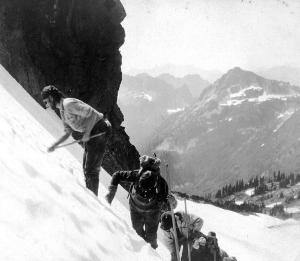
|
 |
Issues
to Consider
What
are the benefits of
scanning the images to
CD-ROM? The major benefit
of the CD-ROM is the
enhanced access to the
collection. Prior to the
availability of the CD (and
currently for unscanned
collections), when a patron
requests images from the
collection (and does not
visit us here to view the
collection in person), the
images are photocopied. We
then either fax or mail the
photocopies to the patron
for selection. This process
is subjective, based on
what I select to send to
the patron. For example, if
a patron wanted to see all
of the Mt. McKinley 1906
images, it would be
necessary for them to
narrow their request, based
on the sheer number of
images. The CD-ROM allows
us to send the entire
scanned collection of
images to the patron for a
nominal price of $25.00.
Selection decisions are
then based on a much
broader range of images.
Another
benefit is that the CD-ROM
makes the process of
reproducing images for
patrons easier and faster.
We currently use two
processes for photographic
print reproduction. The
traditional method involves
printing the image from a
negative in our on-campus
lab. Turn-around time at
the lab can range anywhere
from 5-25 working days,
depending on the work load
at the lab. The
availability of scanned
images on CD-ROM enables us
to print them in house.
Using a Kodak printer with
photographic quality paper
enables us to produce
beautiful images. We are
finding that patrons are
requesting digital copies
of the images more and
more. During the scanning
process, the images were
first scanned at high
resolution and saved and
then bumped down to a low
resolution image and saved.
We have retained the high
resolution images here, so
we can respond quickly to
patron requests. The image
has been scanned and
handled one time to provide
both electronic scans. This
will reduce wear and tear
on the collection, since
future prints/scans can be
copied from the master
CD-ROM.
Finally,
one of the chief benefits
of the CD-ROM is to provide
a record for the Frederick
A. Cook Society. Since the
Cook photograph collection
is split between OSU and
the Library of Congress,
the CD-ROM is a valuable
tool in keeping track of
what images are housed in
which repository.
What
images should be scanned?
We decided what should be
scanned based purely on
past usage of the
collection. The scanning
process is too laborious to
scan images that are never
or little used. Therefore,
we determined that we would
scan all of Dr. Cook's
expeditionary photographs
and the historical
personal/portrait images.
Categories of images that
we decided not to scan at
this time include
categories of images such
as photographs of Cook
Society meetings, Dr.
Cook's travel photographs,
and images of subjects only
tangentally related to the
collection (such as Helene
Vetter's family pets,
etc.). Should there ever
become a demand for these
images, we could later go
back and scan them.
What
resolution should be used?
As mentioned previously,
the images on the CD-ROM
that we provide to patrons
are scanned at low
resolution. We were
concerned with maintaining
control over the
collection, so we did not
want to provide a CD with
high resolution images that
could easily be used in
publication (both digital
and traditional), without
our knowledge and
permission. Publishers must
give proper credit when
using any of our images.
The CD, therefore, is to be
used as a reference tool
for selecting images. Once
selections have been made,
permission forms completed,
and proper fees paid, we
can provide a print or
higher resolution digital
image.
Are
there any disadvantages of
the CD? In order to use the
CD effectively, one must
have a copy of the FACS
finding aid. The file names
on the CD correspond
directly to the box and
folder number where the
original image is housed in
the collection. This makes
it convenient for us to
look up original images, if
necessary. However, it
makes the CD difficult to
use as a stand-alone item.
I
have had some comments
concerning the size of
images on the computer
monitor. Some software
programs are displaying the
images in a very tiny size,
based on the low resolution
of the images. Essentially,
the software is trying to
display the image clearly,
but the low resolution
causes the image size to be
reduced. The software used
to produce the CD was Adobe
Photoshop. This program has
settings that can be
changed to view the image
in a larger format. Other
image programs may have
similar settings.
Another
apparent disadvantage is
the lack of caption
information. However, many
images in the collection
are not captioned anyway.
The best practice here
would be to contact me
concerning particular
images and I can look at
the original to see if
there is, in fact, a
caption.
|
The
'Kite', 1901 |
|
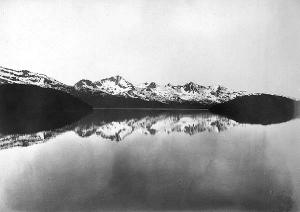
Northern
Greenland shoreline
near Smith Sound

On
the glacier |
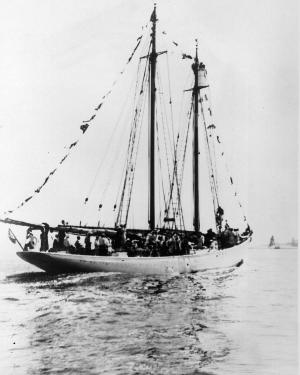
The
Bowdoin, the
expedition's ship |
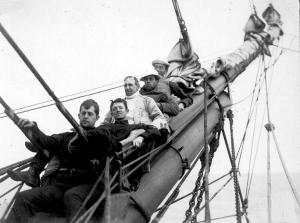
Some
of the crew
Bottom
to top:
Herbert Bern, Prof.
Limond Stone, Louis
Berment, Clarence
Wyckoff & Alfred
Church` |
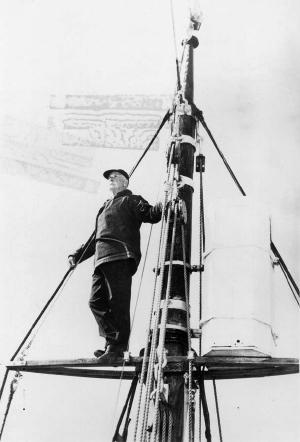
Captain
Moses Bartlett on
the lookout |
What's
Next
Over
all, I believe that the
CD-ROM product has been
successful, and is a
valuable resource. The CD
is especially useful for
projects where a large
number of images is
desired. However, for those
who prefer the old
fashioned way, I am still
happy to provide
photocopies of images for
selection purposes. I am
very interested in feedback
about the CD, so those of
you who have copies, please
contact me with your
comments. Anyone who wishes
to purchase a copy of the
CD can contact me at The
Ohio State University
Archives by phone
(614-688-8173) or e-mail (kissel.4@osu.edu).
Copyright
2005 - The Frederick A.
Cook Society
|